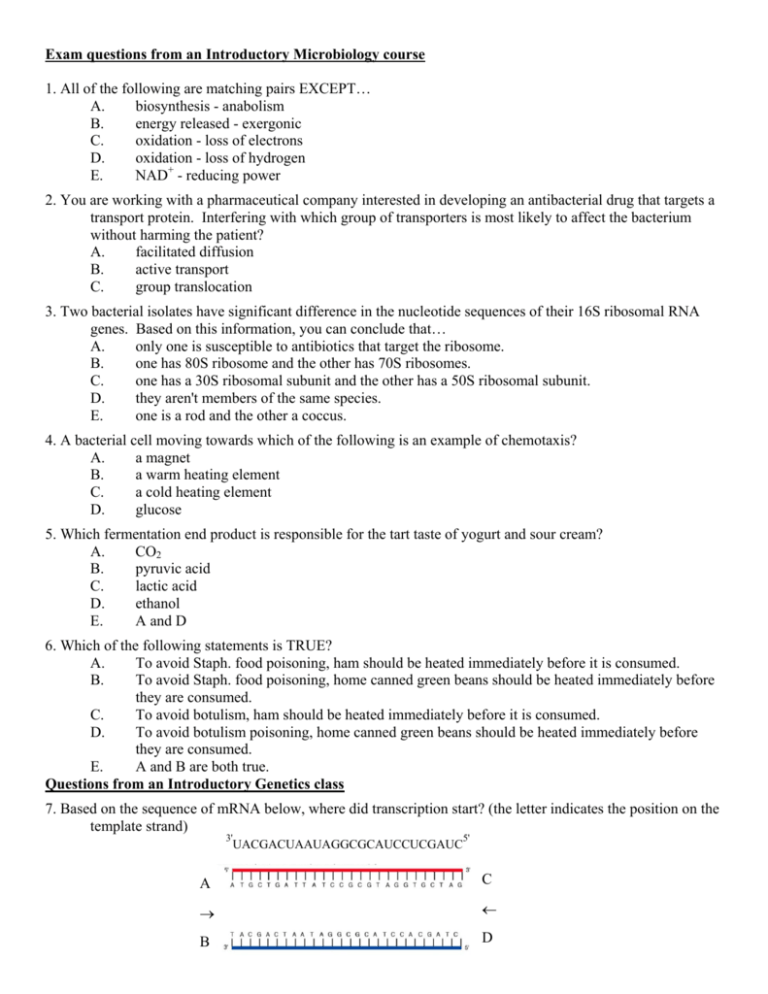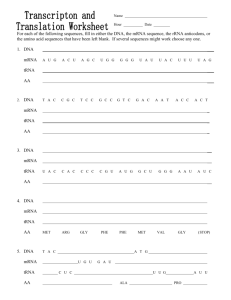Exam questions from an Introductory Microbiology course
advertisement

Exam questions from an Introductory Microbiology course 1. All of the following are matching pairs EXCEPT… A. biosynthesis - anabolism B. energy released - exergonic C. oxidation - loss of electrons D. oxidation - loss of hydrogen E. NAD+ - reducing power 2. You are working with a pharmaceutical company interested in developing an antibacterial drug that targets a transport protein. Interfering with which group of transporters is most likely to affect the bacterium without harming the patient? A. facilitated diffusion B. active transport C. group translocation 3. Two bacterial isolates have significant difference in the nucleotide sequences of their 16S ribosomal RNA genes. Based on this information, you can conclude that… A. only one is susceptible to antibiotics that target the ribosome. B. one has 80S ribosome and the other has 70S ribosomes. C. one has a 30S ribosomal subunit and the other has a 50S ribosomal subunit. D. they aren't members of the same species. E. one is a rod and the other a coccus. 4. A bacterial cell moving towards which of the following is an example of chemotaxis? A. a magnet B. a warm heating element C. a cold heating element D. glucose 5. Which fermentation end product is responsible for the tart taste of yogurt and sour cream? A. CO2 B. pyruvic acid C. lactic acid D. ethanol E. A and D 6. Which of the following statements is TRUE? A. To avoid Staph. food poisoning, ham should be heated immediately before it is consumed. B. To avoid Staph. food poisoning, home canned green beans should be heated immediately before they are consumed. C. To avoid botulism, ham should be heated immediately before it is consumed. D. To avoid botulism poisoning, home canned green beans should be heated immediately before they are consumed. E. A and B are both true. Questions from an Introductory Genetics class 7. Based on the sequence of mRNA below, where did transcription start? (the letter indicates the position on the template strand) 3' 5' UACGACUAAUAGGCGCAUCCUCGAUC A C → ← B D 1. Below are two DNA coding strand sequences. The 5’ ATG encodes the start codon. Tom’s coding DNA sequence is: 5’ ATG CGC TTA CCC TTA CTC CTA TAA3’ Harry’s coding DNA sequence is: 5’ ATG CGC TAA CCC TTA CTC CTA TAA 3’ Harry’s mutation causes the premature termination of: A. Replication B. Transcription C. Translation D. Answer B and C E. All of the above 2. A geneticist isolates a gene for a specific trait under study. She also isolates the corresponding mature mRNA, ready to be read into protein. Upon comparison, the mRNA is found to contain 1,000 fewer bases than the DNA sequence. Did the geneticist isolate the wrong DNA? A. Yes, mRNA is made from a DNA template and should be the same length as the gene sequence. B. Yes, the mRNA should contain more bases than the DNA sequence because bases around the gene are also transcribed. C. No, the ends of mRNA are partially broken down after transcription. D. No, the final mRNA contains only certain sequences from the original mRNA and thus is shorter. 3. Imagine the cell referred to above (the one undergoing meiosis) is a cell that will ultimately produce an egg. Your goal is to pick an oocyte for in vitro fertilization that is free of any recessive alleles. To make sure the oocyte will be free of recessive alleles, you wait until meiosis I is complete, and assay polar body 1(there are two products of meiosis I: polar body 1 and the ooctye) Which of the outcomes diagrammed below will make you confident that you can take the oocyte and fertilize it? (in each case, the larger circle is the ooctye and the smaller circle is polar body 1. 4. The Y and A genes are closely linked on the same chromosome. James (genotype YYAA) and his wife Elise (genotype yyaa) have a son, Pat. Which of the following is true about the gametes that Pat will produce: a. yA & Ya gametes will outnumber YA & ya gametes b. YA & ya gametes will outnumber yA & Ya gametes c. yA, Ya, YA, & ya gametes will be present in equal numbers d. Aa and AA gametes will outnumber Yy and YY gametes e. Yy and YY gametes will outnumber AA and AA gametes Verbs that communicate what you want students to be able to do 1. Remember: arrange, define, duplicate, label, list, memorize, name, order, recognize, relate, recall, repeat, reproduce state. 2. Comprehend: classify, describe, discuss, explain, express, identify, indicate, locate, recognize, report, restate, review, select, translate, 3. Apply : apply, choose, demonstrate, dramatize, employ, illustrate, interpret, operate, practice, schedule, sketch, solve, use, write. 4. Analyze: analyze, appraise, calculate, categorize, compare, contrast, criticize, differentiate, discriminate, distinguish, examine, experiment, question, test. 5. Evaluate: arrange, assemble, collect, compose, construct, create, design, develop, formulate, manage, organize, plan, prepare, propose, set up, write. 6. Create: appraise, argue, assess, defend, estimate, judge, predict, rate, select, support, value, evaluate. Bloom’s Taxonomy of Cognitive Domains Jenny Knight and Mary Pat Wenderoth ASM-CUE 2010, SanDiego Jennifer.Knight@Colorado.EDU mpw@u.washington.edu






